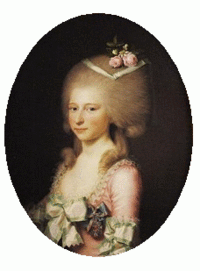Order of Christian VII
The Order of Christian VII, also called "Tessera Concordiæ" was a Danish Order of Knighthood that flourished for some time during the 18th. century. The Danes call it "Christian VIIs Orden" or "Ordenen Tessera Concordiæ".


After the banishment of the adulterous Queen Caroline Mathilde on 17 January 1772 the Royal Danish Court needed a new decoration to replace the Mathilde-Order. King Christian VII of Denmark founded this order on the 21st. of Oktober 1774 as a new decoration that was solely meant for the Danish Royal Family. It was awarded to gentlemen and ladies. The men wore the insignia detached from a ribbon on the left side of the breast. The ladies wore the same insignia on a bow of the same ribbon on their left shoulder.
The painter Jens Juel the Danish princess Princess Louise Auguste of Denmark[1] in 1784. She wore the order of her presumed father Christian VII on a blue ribbon with three silver stripes, almost equel to the earlier Danish Ordre de l'Union Parfaite.
After the death of Queen-Dowager Juliana Maria of Brunswick-Wolfenbüttel in 1796 the order fell into disuse
Literature
- H.F. Grandjean, "De Kongelige Danske Ridderordener" (1903)
- Lars Stevnsborg, "Kongeriget Danmarks Ordener, Medaljer og Hæderstegn" (2005
External links
- ^ Louise Auguste of Denmark, Duchess of Augustenborg or Louise Augusta, (7 July 1771 – 13 January 1843)
